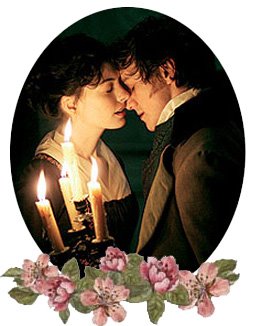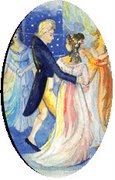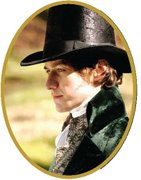Mulberry Tree in Sense & Sensibility
 My dear friend Jane Odiwe (yes, the talented artist who produced a series of Austen Effusions) wrote an email last night, throwing an idea of the link between a mulberry tree, Jane and Tom. Whatta-?
My dear friend Jane Odiwe (yes, the talented artist who produced a series of Austen Effusions) wrote an email last night, throwing an idea of the link between a mulberry tree, Jane and Tom. Whatta-?
Well, as she said, why did Jane write ‘mulberry tree’? Why not apple tree, pear tree, etc that was more… common? In chapter 30 Sense & Sensibility (volume II chapter 8), the kindhearted eternal talker Mrs. Jennings talked of the beauty of Delaford (
Famous tree, eh? And then, our Jane Odiwe remembered the tale of Pyramus and Thisbe, the Babylonian Romeo and Juliet; a tragic romantic tale that involves a particular mulberry tree (speaking of which, the Handel oratorio Susanna that Jane and Tom sang together was also inspired by the story of Susanna of Babylon…). Ah… the tale of star-crossed lovers, the handsome Pyramus and the fair Thisbe… let’s see, shall we? This is the summary of ‘Pyramus and Thisbe’ that was originally written by the Latin writer Ovid and Hyginus:
'An ancient Babylonian legend tells of Pyramus and Thisbe, a handsome youth and a lovely maiden who had lived in adjoining houses from early childhood. The two always played together and after they grew up, they fell in love. Their parents in the meantime had quarreled bitterly over some trifles and forbade their union.
But the two lovers found a chink in the wall dividing the two houses, and every night when everybody else was asleep, they whispered sweet words to each other through the crack in the wall until dawn.
One night, they agreed to meet on the coming night of the full moon outside the city under a white mulberry tree that stood near a bubbling spring close to the tomb of Ninus, the founder of
Thisbe, who arrived first, encountered a lion who had just killed an ox. She fled in terror dropping her veil, which the lion bloodied up while tearing it to pieces. When Pyramus arrived later he found the torn, bloody garment, and believing Thisbe dead, killed himself with his own dagger. The returning Thisbe found her dying lover under the mulberry tree, and in her grief plunged his dagger in her own heart.
The mingling blood of the two unhappy lovers spurted over the mulberry tree, colouring its fruit, and the mulberry tree (Morus rubra) has ever since born blood-red fruit.'
Thus, the meaning of mublerry tree as a symbol of star-crossed love.
Colonel Brandon had his love story with poor Eliza ended when he was in his 20s. When his family learned about his love to the poor girl,
However, bearing in mind Jane’s habit of double (or triple) layers of code hidden in her seemingly trivial passages, I tend to see that the mulberry tree also symbolises another thing.
Pyramus and Thisbe were neighbours. We can also say that Jane Austen and Tom Lefroy were practically neighbours, for Tom’s aunt (Madam Lefroy) lived very close to Steventon. Col. Brandon was in his 20s when he was forced to leave his Eliza behind and went to India for duty. Tom Lefroy was also in his 20s when he left (or was forced to leave) Jane Austen and went to London and Ireland... for duty.
And also, the white mulberry in Ovid’s story grew by a bubbling spring. A bubbling spring...
Our associate librarian Linda (welcome, Linda!) pointed out that in the book ‘Jane Austen's 'Outlandish Cousin' – The Life and Letters of Eliza de Feuillide’ (Faye 2002), there were several letters of Eliza that confirmed Jane’s presence in Bath, including letter dated December 11, 1797 (‘I have heard very lately from our Cousin Jane who is still at Bath with her Mother & Sister, Mr. Hampson whom I saw yesterday and who enquired after yourself and Family, told me he had heard Cassandra was going to be married but Jane says not a word of it – James Austen has been very near losing his second Wife.’). Thus, we can safely say now that Jane was indeed in
Page 14 of the Memoir of Chief Justice Lefroy (Lefroy 1871) says:
'During his [Tom Lefroy’s] stay in Ireland, in 1797, when he came over from London to be called to the Bar, but only to return again for his further study of the Law, he was engaged to be married to Miss Paul. From that time to their marriage, in March 1799, he was allowed to carry on a correspondence, but all the letters he had written to her during their married life were found preserved with a care which marked them as sacred in the eyes of her who was the chief object of his affection.'
If it was true that Tom was engaged with Mary in 1797 (during Easter term – page 20 – which was around April), and that he should go back again to
Okay, coming back to the mulberry ice cream – I mean, tree. What if after Tom’s journey to
Then, somehow, Tom and Jane met again in Bath… had a few days of lovely time (strolling Milsom Street, perhaps… talking of bonnets, muslins, and novels…), then somehow Tom reached the conclusion (or forced to reach such conclusion) that his time with Jane would not last long. That sooner or later, he had to choose. And somehow, after the
Hence, coming back to the death of Pyramus and Thisbe under the mulberry tree that grew by a bubbling spring. The death of a love story in a city of hot springs.
Of course, as Jane Odiwe warned, the mulberry tree might only refer to the ill-fated love between Colonel Brandon and Eliza. But, if the link was so apparent, why did Jane Austen not mention it in her narration? As in pointing out the ‘coincidence’ of Col. Brandon having a mulberry tree in his garden, while at the same time his love was also doomed? I declare, that would be a crispy gossip material for Mrs. Jennings and Mrs. Palmer! But no… not even Mrs. Jennings were aware of the mythological meaning of a mulberry tree.
Well, so far I’ve seen so many evidences of Jane Austen’s genius, and her ability and tendencies to hide her message in layers of code. It is very likely that the mulberry tree indeed refers to the doomed love of Brandon and Eliza. But the existence of the second meaning is also possible… that the mulberry tree symbolises the ill-fated love between Jane Austen herself and Tom Lefroy, despite their attempts to resume their relationship secretly (at least, after January 1796 and before November 1798).
Reference:
Faye, D. L. 2002, Jane Austen's Outlandish Cousin – The Life and Letters of Eliza de Feuillide, British Library Publishing Division, London.
Lefroy, T. 1871, Memoir of Chief Justice Lefroy, Hodges, Foster & Co., Dublin.
Pic 1: A white mulberry tree that was planted by George Washington at Mt. Vernon, Virginia
Pic 2: Pyramus and Thisbe by the mulberry tree
Pic 3: Vincent Van Gogh’s mulberry tree
Pic 4: Marianne, Elinor and Col. Brandon, Sense & Sensibility















































7 comments:
Lovely post. I also like to think, as suggested by Jane Odiwe (thanks again Jane) that there is a chance that Jane and Tom talked of the tale of Pyramus and Thisbe during their time together. If this is true then the reference to a Mulberry Tree may have been inserted into S+S by Jane as a secret message/confirmation to Tom (when he did read her published novel) of their love for each other.
Hmmm... I didn't think of that... Yes, that's also possible. Thanks for that!
So, anyone up to look for the copy of SS owned by Tom Lefroy, hidden in a dusty corner in Carigglas or somewhere in Ireland? :-D
Rachel? :-D
Brilliant work, Icha!
"later he found the torn bloody garment"---sounds a little like Jane's little joke about Tom Lefroy's white coat--apropos which....Tom Jones's white coat acquires a red coloration from his own dried blood after his fight with the Ensign in the Inn at Upton. ;)
And fruit trees of all kinds play a subtle but significant role in several of Jane Austen's novels--the chapter on the allusive meaning of all those fruit trees would make a very long chapter in the Hartfield edition of her novels! ;)
The Tom Jones reference! Blimey, I didn't see that! Thanks, Arnie!
And when will you write down the chapter of allusive meaning of fruit trees in JA's novels? I would LOVE to read them!
It all comes back to the Tree of Knowledge in the Garden of Eng-...I mean, the Garden of Eden. ;)
Hi Icha!
Read the following post at my blog, including my comment thereto which references this post in your blog!:
http://sharpelvessociety.blogspot.com/2012/08/the-shakespearean-web-of-jane-austens.html
Cheers, ARNIE
@JaneAustenCode on Twitter
Hi Arnie. Good to see you back. How are things?
Thanks for referencing us. Rachel
Post a Comment